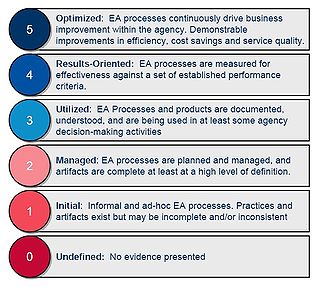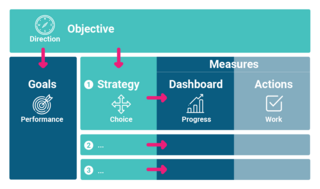Project management is the process of leading the work of a team to achieve all project goals within the given constraints. This information is usually described in project documentation, created at the beginning of the development process. The primary constraints are scope, time, and budget. The secondary challenge is to optimize the allocation of necessary inputs and apply them to meet pre-defined objectives.
A performance appraisal, also referred to as a performance review, performance evaluation, (career) development discussion, or employee appraisal, sometimes shortened to "PA", is a periodic and systematic process whereby the job performance of an employee is documented and evaluated. This is done after employees are trained about work and settle into their jobs. Performance appraisals are a part of career development and consist of regular reviews of employee performance within organizations.
A marketing plan is a strategy or outline created to accomplish a marketing team's objectives. A marketing plan is often created together by marketing managers, product marketing managers, product managers, and sales teams. A marketing plan falls under the umbrella of the overall business plan.
Management by objectives (MBO), also known as management by planning (MBP), was first popularized by Peter Drucker in his 1954 book The Practice of Management. Management by objectives is the process of defining specific objectives within an organization that management can convey to organization members, then deciding how to achieve each objective in sequence. This process allows managers to take work that needs to be done one step at a time to allow for a calm, yet productive work environment. In this system of management, individual goals are synchronized with the goals of the organization.
Goal setting involves the development of an action plan designed in order to motivate and guide a person or group toward a goal. Goals are more deliberate than desires and momentary intentions. Therefore, setting goals means that a person has committed thought, emotion, and behavior towards attaining the goal. In doing so, the goal setter has established a desired future state which differs from their current state thus creating a mismatch which in turn spurs future actions. Goal setting can be guided by goal-setting criteria such as SMART criteria. Goal setting is a major component of personal-development and management literature. Studies by Edwin A. Locke and his colleagues, most notably, Gary Latham have shown that more specific and ambitious goals lead to more performance improvement than easy or general goals. Difficult goals should be set ideally at the 90th percentile of performance,assuming that motivation and not ability is limiting attainment of that level of performance. As long as the person accepts the goal, has the ability to attain it, and does not have conflicting goals, there is a positive linear relationship between goal difficulty and task performance.
A business case captures the reasoning for initiating a project or task. Many projects, but not all, are initiated by using a business case. It is often presented in a well-structured written document, but may also come in the form of a short verbal agreement or presentation. The logic of the business case is that, whenever resources such as money or effort are consumed, they should be in support of a specific business need. An example could be that a software upgrade might improve system performance, but the "business case" is that better performance would improve customer satisfaction, require less task processing time, or reduce system maintenance costs. A compelling business case adequately captures both the quantifiable and non-quantifiable characteristics of a proposed project. According to the Project Management Institute, a business case is a "value proposition for a proposed project that may include financial and nonfinancial benefit."

The nursing process is a modified scientific method which is a fundamental part of nursing practices in many countries around the world. Nursing practise was first described as a four-stage nursing process by Ida Jean Orlando in 1958. It should not be confused with nursing theories or health informatics. The diagnosis phase was added later.
Organizational effectiveness is a concept organizations use to gauge how effective they are at reaching intended outcomes. Organizational effectiveness is both a powerful and problematic term. It may be used to critically evaluate and improve organizational activities; this is one of its strengths. However, the term has been noted as problematic as it means various things to different individuals. Furthermore, there are alternative methods for measuring organizational performance. Organizational effectiveness embodies the degree to which firms achieve the goals they have decided upon, a question that draws on several different factors. Among those are talent management, leadership development, organization design and structure, design of measurements and scorecards, implementation of change and transformation, deploying smart processes and smart technology to manage the firm's human capital and the formulation of the broader Human Resources agenda.
Performance-based budgeting is the practice of developing budgets based on the relationship between program funding levels and expected results from that program. The performance-based budgeting process is a tool that program administrators can use to manage more cost-efficient and effective budgeting outlays.

Internal auditing is an independent, objective assurance and consulting activity designed to add value and improve an organization's operations. It helps an organization accomplish its objectives by bringing a systematic, disciplined approach to evaluate and improve the effectiveness of risk management, control and governance processes. Internal auditing might achieve this goal by providing insight and recommendations based on analyses and assessments of data and business processes. With commitment to integrity and accountability, internal auditing provides value to governing bodies and senior management as an objective source of independent advice. Professionals called internal auditors are employed by organizations to perform the internal auditing activity.
Strategic communication can mean either communicating a concept, a process, or data that satisfies a long-term strategic goal of an organization by allowing facilitation of advanced planning, or communicating over long distances usually using international telecommunications or dedicated global network assets to coordinate actions and activities of operationally significant commercial, non-commercial and military business or combat and logistic subunits. It can also mean the related function within an organization, which handles internal and external communication processes. Strategic communication can also be used for political warfare.

Participatory impact pathways analysis (PIPA) is a project management approach in which the participants in a project, including project staff, key stakeholders, and the ultimate beneficiaries, together co-construct their program theory.
A goal or objective is an idea of the future or desired result that a person or a group of people envision, plan, and commit to achieve. People endeavour to reach goals within a finite time by setting deadlines.

The Enterprise Architecture Assessment Framework (EAAF) was created by the US Federal government Office of Management and Budget (OMB) to allow federal agencies to assess and report their enterprise architecture activity and maturity, and advance the use of enterprise architecture in the federal government.
Strategy implementation is the activities within a workplace or organisation designed to manage the activities associated with the delivery of a strategic plan.
In business, operational objectives are short-term goals whose achievement brings an organization closer to its long-term goals. It is slightly different from strategic objectives, which are longer term goals of a business, but they are closely related, as a business will only be able to achieve strategic objectives when operational objectives have been met. Operational objectives are usually set by middle managers for the next six to twelve months based on an organisation's aim. They should be attainable and specific so that they can provide a clear guidance for daily functioning of certain operations. This business term is typically used in the context of strategic management and operational planning.

Theory of Change (ToC) is a methodology or a criterion for planning, participation, adaptive management, and evaluation that is used in companies, philanthropy, not-for-profit, international development, research, and government sectors to promote social change. A Theory of Change of a social program defines its long-term goals and then maps backward to identify necessary preconditions.
The agreement on objectives is an agreement concerning the goals to be achieved by the employee. It is a motivational technique and standardly used in field service and in project work, but also in other areas. Besides trade and industry, it is also increasingly used in public administration.
Objectives and key results is a goal-setting framework used by individuals, teams, and organizations to define measurable goals and track their outcomes. The development of OKR is generally attributed to Andrew Grove who introduced the approach to Intel in the 1970s and documented the framework in his 1983 book High Output Management.

Objectives, goals, strategies and measures (OGSM) is a goal setting and action plan framework used in strategic planning. It is used by organizations, departments, teams and sometimes program managers to define and track measurable goals and actions to achieve an objective. Documenting your goals, strategies and actions all on one page gives insights that can be missing with other frameworks. It defines the measures that will be followed to ensure that goals are met and helps groups work together toward common objectives, across functions, geographical distance and throughout the organization. OGSM’s origins can be traced back to Japan in the 1950s, stemming from the process and strategy work developed during the Occupation of Japan in the post-World War II period. It has since been adopted by many Fortune 500 companies. In particular, Procter & Gamble uses the process to align the direction of their multinational corporation around the globe.






